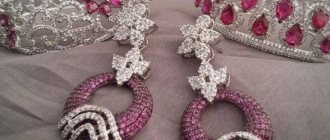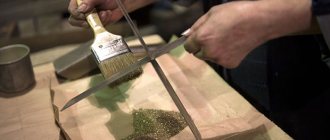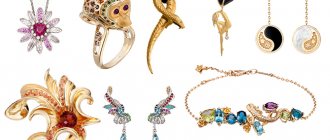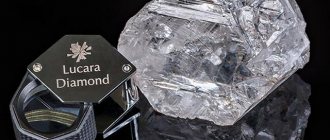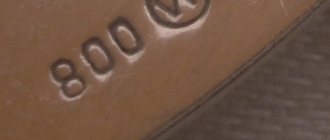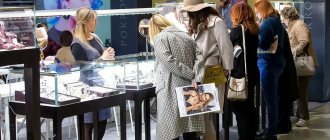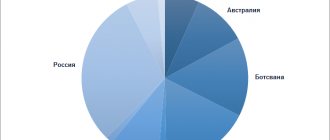The volume of jewelry sales in Russia in monetary terms will remain unchanged for the third year and at the end of 2022 will amount to approximately 240 billion rubles. But in physical terms (products in pieces and grams) a drop of 15% to 20% is expected. This forecast was made in a conversation with Forbes by Eduard Utkin, general director of the Guild of Jewelers (unites more than 100 manufacturers and sellers of jewelry in Russia).
The industry is shrinking. According to the guild, the number of jewelry factories in Russia has decreased from 4,500 last year to 3,500 this year, stores - from more than 20,000 to 12,000-15,000, and the number of employees in the industry - from 160,000 to approximately 100,000 people. The Moscow Jewelry Factory, for example, closed 35 stores in 2022.
Cashback of 200%: how a jewelry chain with signs of a financial pyramid operates in Russia
Advertising on Forbes
There is a slight increase only in the number of jewelry repair shops: from 5,300 to more than 6,000, respectively. This is due to the fact that people cannot now afford to buy new jewelry and are trying to repair old ones, explains Utkin.
"Golden" raw materials
The main problem is rising prices for raw materials. The cost of gold and precious stones has increased by 50-60% since last year. Precious metals and stones account for 85-90% of the cost of the product, Utkin notes.
According to the Central Bank, in December 2022, the price of gold was 2900-3000 rubles per gram, silver 34-35 rubles per gram. Last year, we received an increase in prices for gold by 50%, and for silver by 75%, says Utkin. A gram of gold in December 2022 already cost 4300-4500 rubles, silver - 60-61 rubles.
Endless liquidation: how the Sunlight jewelry chain made billions from cheap diamonds and became an Internet meme
Stones are not an exchange commodity. According to the Jewelers Guild, natural stones have risen in price two to three times over the same period. For example, the most popular stone, topaz, has increased in price from $5 per carat to $11-12.
The rise in prices has significantly hit producers; due to a shortage of working capital, they cannot purchase gold in sufficient quantities and produce products, Utkin notes. Thus, according to the Jewelers Guild, in 2022, 57 tons of gold jewelry were produced, 30 million pieces were hallmarked. In 2022, only 39 tons of products were produced and 21 million pieces were branded. The downward trend will continue this year, the expert is sure.
Only luxury grows
The increase in the cost of products from the manufacturer forces retail chains to raise prices. “Last year, retail maintained a certain inventory of products at old prices, but now this is not the case. Prices are creeping up, they have already increased by about 30%, and this is not the limit,” warns Utkin.
According to him, the mass segment suffered the most; sales in volume terms fell by 30% last year. At the same time, the luxury segment has doubled. Those who previously bought jewelry abroad and are now unable to travel due to the pandemic are purchasing items in Russia, explains Utkin. The greatest demand is for products with rare natural stones - rubies, emeralds, sapphires, garnets, aquamarines, tourmalines, tanzanites.
“Customers appreciated the comfort of purchasing goods in Russia. We have a wide selection of models, a high level of service and all duties are included. In addition, prices for watches and jewelry are competitive compared to Europe. All this became an important factor for sales growth,” the Mercury company’s press office explained to Forbes. Jewelry sales in January - June 2022 at Mercury increased by more than one and a half times compared to the same period last year. The company notes an increase in interest in watches and jewelry as investments. For example, there has been an increase in demand for watches with complex functions, such as Patek Philippe, all Rolex models and jewelry with exceptional characteristics, confirmed by international certificates.
“Sales of jewelry in the premium and luxury categories are constantly growing, year after year. In this segment, we have never observed a decline and we are not seeing it now,” Anastasia Sarantseva, director of sales and development of the Moscow Jewelry Factory, told Forbes. “We classify jewelry worth 1 million rubles and more as luxury.”
In the first quarter of 2022, sales of expensive diamond jewelry increased by 20% compared to the same period in 2020, says Dmitry Dosko, commercial director of the Adamas jewelry store chain. Quantitatively, sales have decreased, he confirms. But the growth of the average receipt (both due to the cost of a unit of goods sold and the number of items in the receipt) outweighs this drop by almost half. “Our revenue from operating stores now exceeds the values in 2022,” Dosko assures.
When will the industry recover?
The year 2020 began for goods in the luxury segment, which includes jewelry with diamonds, well - demand for them continued to grow after an active recovery in the second half of 2019, recalls Sergei Ivanov, head of the Russian diamond mining company, one of the three largest diamond companies, in an interview with TASS companies of the world. Thus, in the United States, which accounts for about 50% of the total diamond jewelry market, demand grew by 4-5% compared to last year - until there was a reversal associated with restrictive measures to contain the coronavirus and a general deterioration in consumer sentiment among clients.
According to him, a positive factor for the industry is that the cutting segment managed to improve its health in 2022 - reduce the debt burden of enterprises and bring inventory levels back to normal. “In turn, leading diamond producers have taken on a significant burden to stabilize the situation in the industry. Thus, we have reduced the redemption requirements for our diamonds to almost zero, which allowed the cutting and retail sector not to increase inventories and, accordingly, the debt burden during a period of falling demand for jewelry. Such a sales strategy will allow us to accelerate our entry into the recovery trajectory,” the head of Alrosa is confident.
Sales of luxury goods in the world may fall by 15-35% at the end of this year, and the sales level of 2022 will be achieved in 2022-2023, Ivanov refers to expert estimates. “But if we are talking about the diamond jewelry market, then 2022 was the second year of record high sales in a row. In my opinion, the market recovery will depend on the pace of restoration of household incomes, and therefore on how successful the period of returning the economy to pre-crisis levels will be,” concluded the head of Alrosa, noting that the situation is developing differently around the world, and a lot depends on when stores will open after quarantine.
According to the World Gold Council (WGC), global demand for jewelry in January-March 2022 fell by 39%, to a record low of 325.8 tons due to restrictive measures imposed by world governments due to... for pandemics. In China, the largest consumer of jewelry and the first market to experience an outbreak of the disease caused by the coronavirus, demand fell by 65%. John Mulligan, director of interaction with board members and markets of the WGC, in an interview with TASS, noted that the timing of the recovery of the jewelry sector is difficult to estimate, however, the removal of barriers to the acquisition of physical gold and the restoration of consumer sentiment will undoubtedly lead to increased demand. Mulligan estimates it could take "several blocks."
Retailers and the Russian Jewelers Guild are not so optimistic in their assessments. Thus, a representative of Bronnitsky Jeweler notes that the recovery period will be long and will take two to three years. The head of the guild believes that, against the backdrop of declining household incomes, measures to overcome the pandemic proposed by the Russian government will play an important role, but even in the most optimistic scenario, recovery will take at least a year. If recovery takes several years, about half of trade enterprises may decide to close their businesses until better times, he did not rule out.
The epidemic almost killed the market
The coronavirus epidemic and related restrictions last year led to an almost complete stop in the work of manufacturers. Due to mall closures, many jewelry chains were closed for an average of two to four months.
Of all the retail segments, the jewelry market suffered the most, notes General Director of Infoline-Analytics Mikhail Burmistrov. Retailers were forced to close retail facilities that, due to a decrease in traffic, turned out to be economically ineffective, he recalls.
Last summer, the jewelry chain “585 Gold” and Moscow Jewelry announced a reduction in the number of stores. “In general, the unstable economic situation, a sharp decline in purchasing power and a reorientation of demand for food and medicine have led to the fact that sales of jewelry have stalled, because this is not an essential item,” recalls Utkin.
Since the industry was not included in the list of those most affected, the Guild of Jewelers in April 2022 appealed to the Minister of Industry and Trade Denis Manturov. Without government support, the consequences for the industry will be catastrophic, the jewelers wrote. They asked to provide the industry with a tax holiday, restructure loans, transfer rent payments to a percentage of revenue, reduce insurance rates and increase unemployment benefits.
Advertising on Forbes
“Family companies sometimes make decisions that seem reckless”: the head of Tous in Russia - on how jewelry brands are surviving the pandemic
As a result, the jewelry trade was included in the list of victims (they were able to take advantage of government support measures: loans for wages, preferential rates for social insurance, etc. - Forbes ), but Russian manufacturers were left with nothing, Utkin complains. “There is some kind of disdainful attitude towards jewelers in Russia. Everyone thinks that they are already rich because they produce luxury goods, but no one digs up gold in their garden,” he says.
Almost all production in Russia is focused on producing products in the budget price segment, where the average bill is 8,000 rubles. These are mainly individual jewelry made of silver and lightweight gold items. 98% of enterprises in the industry belong to small and micro businesses, notes Utkin; in the regions of traditional jewelry production, the family format has been developed, says Maxim Guterman, commercial director of jewelry (Karatov brand).
Results and prospects: “If you want to make God laugh, tell him about your plans”
Operating expenses after opening the showroom: about 400 thousand rubles (about $5325) per month. For now, we are achieving profitability after quarantine only through landlord discounts. In July, thanks to participation in pop-up markets, we were able to sell more than 50 units of goods. The plans are to double this amount and achieve revenue of 800 thousand rubles (about $10,800) per month by the end of the year.
Our showroom is also an office for an online store. This is one of the reasons why the showroom format was chosen rather than a store (street retail). Two managers, working on a 2/2 schedule, are able to both process online orders and provide attention to the incoming flow of customers. For the convenience of customers, online orders can be made both on the website and on Instagram or WhatsApp.
Photo from personal archive
In addition to targeted advertising on social networks, from December to April we launched contextual advertising and analyzed clicks using e-commerce. The initial idea was to launch an advertisement aimed at men who are looking for what to give as a gift, since now the average price of a good bouquet is close to the average price of our products - 7-8 thousand rubles (about $90-100). I planned to compete in this market. But it turned out that for all keywords about gifts and flowers, the cost per click is very high. Therefore, we abandoned this option.
Now we are working with bloggers - opinion leaders. These are mostly stylists. We do not use barter and choose bloggers who understand this. We bring our products to them, they “test it” and then review it and combine it with their “looks”. We had experience when the stylists themselves asked to bring some collections in order to show a complete image, selection of clothes and accessories in the offline group.
Photo from personal archive
We also very much welcome various collaborations with stylists, clothing brands and even nutritionists. We organize joint filming and offline events.
I have outsourced SMM specialists who handle advertising and maintain pages on social networks. However, at the moment I am doing all the visuals and design myself. Even before the pandemic, I wanted to make the account more lively, since a catalog is always a catalog: everything is very beautiful, but I want to see it “live.” During quarantine, I had a lot of free time and a desire to distract myself from depressive thoughts - so I started taking photographs, looking for “tasty” images and came to today’s style of our Instagram.
I answer all comments and requests not related to orders on social networks myself. In my opinion, it is important for the client to feel that the brand owner is talking to them.
Photo from personal archive
Of course, there is competition in the market. I constantly analyze those who work with me in the same “field”. Our competitors can be divided into 3 groups :
- Massmarket brands . They are famous, but their products are stamped, mass produced, they are in every shopping center, they are not exclusive. However, exclusivity is not important to all buyers.
- Modern designers are mostly Russian. But most of them are of artisanal quality, the design is not up to par. But many of them are cheaper, since the cost of production is lower and there are no import duties. Many do not even undergo the hallmarking procedure in the assay office, so the composition of the product remains a mystery to the consumer.
- Multi-brand stores , which present different designers, Russian and foreign. I identified 11 such competitors - in general, not many. But among them there are those who have been on the market for a long time and operate with mass market tools, which allows them to attract more customers and achieve recognition.
My plans for the next 2 years are to increase the number of factories that supply jewelry to 5, introduce a line of men’s jewelry, expand the clothing line, release a collection of eco-leather bags, and open a branch in London. But, as they say, if you want to make God laugh, tell him about your plans!
Rescue on the Internet
Remote trade in jewelry could significantly help retail chains, but it became possible only in December 2019, recalls Eduard Utkin. Prior to this, the country was subject to a 1992 presidential decree prohibiting the industry from trading online. Before the crisis, sales of most jewelry companies via the Internet did not exceed 4% of turnover, so the companies were not ready to work in a pandemic. “But they figured it out pretty quickly and within one or two months they launched their own online trading or went to marketplaces. Thus, many managed to increase the share of online sales in turnover to 10-12%,” notes Utkin.
Advertising on Forbes
Mercury launched online sales of watches and jewelry in March 2022. This area is actively developing and has great potential (up to 500,000 unique users per month), the company notes. The overall level of online sales in 2022 doubled compared to 2022.
Online trading has become a way out for Adamas, admits Dmitry Dosko. However, jewelry is a product that buyers still want to try on and touch in person before purchasing, says Dosko.
For the SOKOLOV brand, the online channel provides about 30% of revenue; the audience of the online store has reached 3 million people per month, says managing partner of the brand Artem Sokolov. As a result, the company closed 2020 with a 60% increase in operating profit.
The Moscow Jewelry Factory is also recording an increase in online sales: their share has grown to 15% compared to 7-8% a year ago.
Jewelry became one of the fastest growing categories last year, marketplaces admit. Over the past year, turnover from jewelry sales at Ozon increased 5.4 times, notes Iloanga Ershova, director of business development at Ozon. And in 2022, the trend continued: turnover from jewelry sales in the first quarter of 2022 increased fourfold year-on-year, while the average bill did not increase relative to the indicators in the first quarter of last year and is about 2,000 rubles.
Advertising on Forbes
In 2022, the turnover of jewelry products at Wildberries reached 5 billion rubles, and from January to May 2021 - 2.6 billion rubles, which is 50% more than in the same period last year, a company representative said. The average bill in 2022 was about 1,655 rubles; in five months of 2021 it grew to 1,688 rubles. Now Wildberries has 1,067 suppliers selling jewelry, their number has almost tripled year on year. The number of entrepreneurs and jewelry brands has increased fivefold from December 2022 to December 2022 on Ozon. At the end of the first quarter of 2022, the number of sellers on the marketplace increased more than four times year on year.
I came up with a business on the plane: “I decided to bring to Russia something that was previously unavailable”
“I didn’t start my own business right away. She studied at the Financial Academy under the Government of the Russian Federation, received an MBA in strategic management, and then completed a huge number of different trainings: from the art of sales to financial analysis. My professional background also includes experience in the banking sector, where I worked my way up from sales manager to director of the department for working with foreign companies. And in 2022, she radically changed her field of activity and moved to a large company from the beauty industry, working as a commercial and executive director. After some time, I realized that it was time to try myself as an entrepreneur.
My family vacationed in Spain in the summer, and I flew to them on weekends when I could. It was during such a flight that the idea of creating my own business was born. I felt that I could and wanted to manage processes and make decisions myself.
Photo from personal archive
I began to formulate the basic principles on which my business would be built. I clearly understood that my business had to be something new on the market. It was important to me that it would bring more aesthetics into people’s lives and fill it with beauty. In addition, I wanted to be able to use not only my skills in management and finance, but also my creative potential. I decided that my employees should be a team of like-minded people, and the company should be built on principles close to “turquoise”. It was with these thoughts that it all began - right on the plane I started writing a business plan.
The idea for the business came together quite quickly. I remembered that I had not seen anything attractive in jewelry stores in Russia for a long time. I had long noticed that my attitude towards jewelry had changed a lot since my loved ones began to give me things bought in small jewelry boutiques in Europe and Israel. My friends always paid attention to my unusual accessories. I decided that I should bring to Russia something that is not yet available to local customers.
